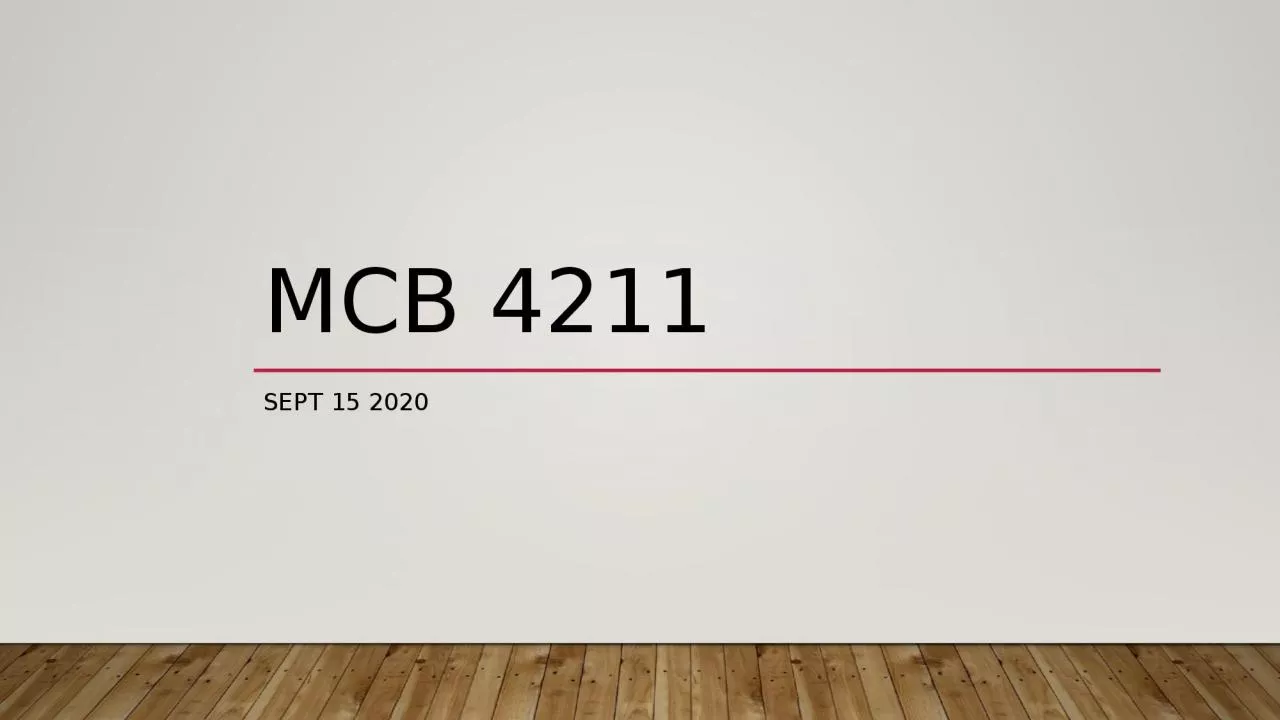

What are the structural characteristics of antibodies Reading Immunobiology textbook Chapter 4 Antigen recognition by B cell and T cell receptors A Immunoglobulin structure 1 subunit structure ID: 934499
Download Presentation The PPT/PDF document "MCB 4211 Sept 15 2020 Lecture:" is the property of its rightful owner. Permission is granted to download and print the materials on this web site for personal, non-commercial use only, and to display it on your personal computer provided you do not modify the materials and that you retain all copyright notices contained in the materials. By downloading content from our website, you accept the terms of this agreement.
Slide1
MCB 4211
Sept 15 2020
Slide2Lecture:
What are the structural characteristics of antibodies?
Reading: Immunobiology textbook Chapter 4: “Antigen recognition by B cell and T cell receptors”A. Immunoglobulin structure1. subunit structure2. heavy and light chains3. Immunoglobulin fragments and their uses: Fc, Fab, and F(ab’)2B. Antigenic determinants of immunoglobulins1. isotypes and subclasses 2. idiotypes3. allotypes
Quiz #1: 10 questions
will focus on the material presented to date
Slide3Terminology
Antigen (Ag) recognized by
TcR or BcRAntibody (Ab) on surface of a B cell is BcR(note: B cells come from Bursal of Fabricius in birds, or Bursal equivalent; bone marrow in mammals)(note: T cells come from the Thymus)Antibodies were found in the gamma fraction of electrophoretic separation, and were noted to be globular proteins, so then termed ”gamma globulins”. When specifically functioning as antibodies, they were also called immunoglobulins (Ig)
Slide4Y
Basic structure of an antibody/immunoglobulin
Slide5Light Chain is 25
KDa
Heavy Chain is 50 Kda2H2L is 150KDabilaterally symmetricalInterchain bondsH and L chains held together by disulfide bridgesH chains held together by disulfide bridgesIntrachain disulfide bondsThere are disulfide bridges that define the ends of immunoglobulin domainsTypical structure of antibody
Slide6Immunoglobulin domains
The H and L chains are composed of individual domain structures that are marked by cysteines at the end (the contribute the SH groups for SS bonds)
These domains are found in many other proteins as well (examples include TcR, CD4, CD8, MHC class I and MHC class II
These are all members of the
Immunogloblulin
supergene family of genes
Slide7Possible source of amplified genetic material that produces deletions and duplications
Slide8Results of these gene duplications and deletions:
Too much duplication or deletion can be lethal configuration
But, where the deletions/duplications are smaller, they are survivable, and offer the opportunity to mutate the second copy to a new functionWe see this ABBA type structure of genes in, for example, the MHC, which may be an example of this mechanism
Slide9Fragmenting antibody with Enzymes
Papain (from Papaya) cuts above the hinge region and produces two different fragments: Fab (monovalent fragment antigen binding) and Fc (Fragment crystallizable)
Fab is monovalentFc region mediates FcR binding Pepsin cuts below the hinge and also digests the portion to smaller peptides; the main fragment is a bivalent F(ab’)2
Slide10Predict the effect of adding Fab fragments to a system of (antibody plus antigen) where the Ab + Ag can produce immune complexes
Predict the effect of adding F(ab’)
2 fragments to a system of (antibody plus antigen) where the Ab + Ag can produce immune complexes
Slide11Kabat and Wu; sequencing Bence Jones Proteins
Bence Jones proteins are monoclonal light chains that appear in urine of B cell tumor (neoplastic plasma cells)
Kabat and Wu sequenced the VL domains of a number of different cancer patients and assembled a variability plot from the data
Slide12They identified three
Hypervariable regions amongst “framework residues” that are more consistent between individual antibody sequences on both the H and L chains
Slide13Slide14Five different classes or isotypes of antibodies in mammals
https://
www.prosci-inc.com/resources/antibody-development-guide/antibody-structure-and-properties/J chainyesnoyesnono
Slide15Immunoglobulin Heavy chains
IgM
IgGIgAIgDIgEHeavy chain classm, mug,gammaa, alphad, deltae, epsilonImmunoglobulin light chains
Light chain class
l
, lambda
k
,kappa
Beyond isotypes, there are other antigens associated with antibody structure
Idiotype: the antigenic character of the antigen binding site
Allotype: allelic shapes encoded by alleles of the Ig H and L genes that are inherited
Note: you can make anti-idiotypic antibodies,
etc
NOTE: you can make antibodies to the antigens characteristic of antibodies
Slide16The T cell receptor (
TcR
) also has variable regions that interact with antigenBUT the interactions are not with soluble antigen
Slide17Now for the quiz…
Slide18Next slides for next lecture
Slide195 forces the contribute to Ab binding to Ag
Individually weak, but many of them combine to make high affinity interactions
Affinity of antibody is measured as affinity constant[Ab] [Ag][AbAg]KA=[Ab] [Ag]
[
AbAg
]
K
A
is association constant or affinity
This is a calculation for a monovalent Fab. Bivalent antibodies have much higher apparent association with antigen called AVIDITY
Slide20How to measure affinity: Equilibrium dialysis
Other measures: Surface plasmon resonance